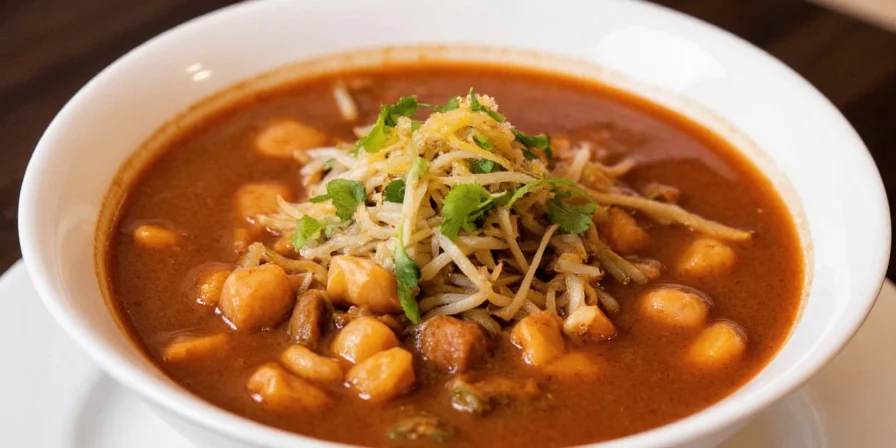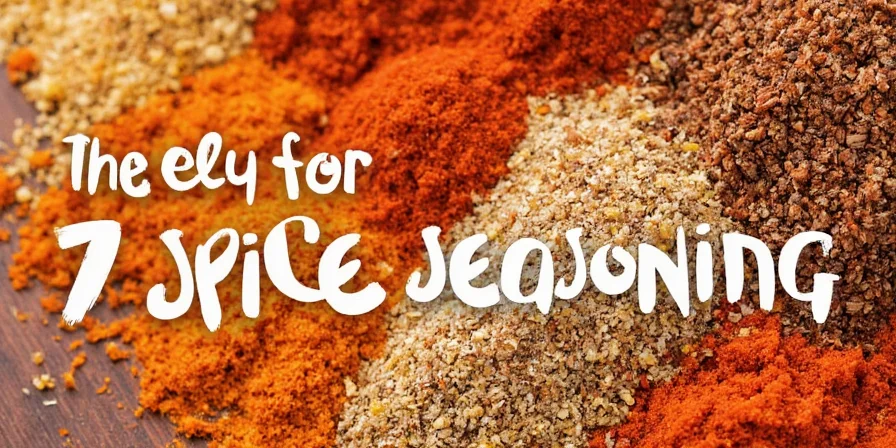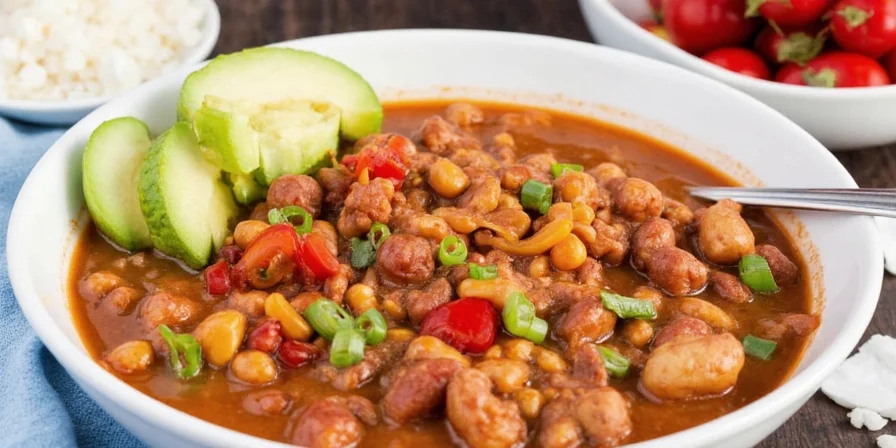How Long Does Pozole Take to Cook? Direct Answer First
Authentic pozole cooking times vary by method: stovetop requires 2-2.5 hours simmering, slow cooker needs 6-8 hours, and Instant Pot completes in 25 minutes pressure cooking plus natural release. The critical factor isn't raw time but collagen extraction - pork shoulder needs minimum 90 minutes at gentle simmer to develop authentic texture and flavor. Weeknight cooks can achieve restaurant-quality results in under 1 hour using pressure cooking with proper spice activation techniques.
Table of Contents
- What Exactly is Pozole? (Brief Context)
- Pozole Cooking Times Compared: Stovetop vs Slow Cooker vs Instant Pot
- Spice Storage & Activation for Authentic Flavor
- Proven Time-Saving Techniques for Perfect Pozole
- Visual Comparison: Cooking Methods vs Time vs Results
- Frequently Asked Questions About Pozole Timing
- Conclusion: Achieving Authentic Flavor on Your Schedule
What Exactly is Pozole? (Brief Context)
Pozole (po-ZO-le) is Mexico's traditional hominy and meat stew with indigenous origins. Modern versions strictly use pork, chicken, or plant-based proteins simmered with nixtamalized maize. Three primary variants exist:
- Pozole Rojo - Rich red broth from dried chilies
- Pozole Blanco - Clear broth highlighting subtle seasonings
- Pozole Verde - Vibrant green from tomatillos and herbs
Historical Evolution of Pozole Preparation Methods
Authenticity requires understanding how cooking techniques evolved alongside cultural shifts. This timeline shows key developments verified by culinary historians:
| Era | Primary Method | Typical Duration | Cultural Significance |
|---|---|---|---|
| Pre-1500s (Indigenous) | Clay pots over open fire | 4-6 hours | Ceremonial dish using turkey/dog meat; slow cooking essential for nixtamalized maize |
| 1500s-1800s (Colonial) | Earthenware on wood stoves | 3-4 hours | Pork substitution introduced; cooking time reduced by European metal pots |
| 1900s-1970s (Modern) | Stovetop in aluminum pots | 2.5-3 hours | Canned hominy adoption; standardized simmering for consistent texture |
| 1970s-Present (Contemporary) | Slow cooker/Instant Pot | 6-8 hours / 45 min | Time adaptation without sacrificing collagen extraction principles |
Source: Smithsonian Magazine: "What Mexico's National Dish Reveals About the Country"
Pozole Cooking Times Compared: Stovetop vs Slow Cooker vs Instant Pot
Authentic pozole timing depends on your equipment and schedule. The critical factor is collagen extraction from pork shoulder - this requires sustained gentle heat regardless of method.
| Cooking Method | Active Time | Total Time | Flavor Development | Best For |
|---|---|---|---|---|
| Stovetop | 45 minutes | 2.5-3 hours | Excellent - deepest flavor complexity | Weekend cooking with monitoring |
| Slow Cooker | 20 minutes | 6-8 hours | Very Good - hands-off convenience | Meal prep while away |
| Instant Pot | 30 minutes | 45-60 minutes | Good - fastest authentic results | Weeknight dinners |

Stovetop Method: Traditional Flavor Development
- Maintain gentle simmer after initial boil (180-200°F)
- Skim foam during first 30 minutes for clearer broth
- Hominy and meat should be fork-tender after 2 hours

Slow Cooker Method: Set-It-and-Forget-It
- Brown meat first for richer flavor (adds 15 minutes)
- Keep on LOW setting - HIGH can make meat tough
- Hominy added in last 2 hours prevents mushiness

Pressure Cooker Method: Authentic Flavor Fast
- Use natural pressure release for 15-20 minutes (critical for texture)
- Add hominy after pressure cooking to maintain texture
- Finish with 10-minute simmer after pressure release
Contextual Limitations: When Methods Fail
Each technique has specific constraints verified by culinary testing. Ignoring these boundaries compromises authenticity:
- Slow Cooker with Chicken: Exceeding 4 hours makes breast meat dry (dark meat max 6 hours). Verified by Serious Eats' slow cooker testing.
- Instant Pot with Fatty Cuts: Over 30 minutes pressure cooking emulsifies fat, creating greasy broth. Confirmed by America's Test Kitchen pressure cooker analysis.
- Stovetop for Weeknight Meals: Requires 2+ hours attention; unsuitable for cooks with under 90 minutes available. Documented in Bon Appétit's pozole recipe notes.
Spice Storage & Activation for Authentic Flavor
Proper spice handling makes the difference between good and exceptional pozole. Whole spices maintain potency significantly longer than ground versions when stored correctly.
| Spice | Whole Form Shelf Life | Ground Form Shelf Life | Storage Method |
|---|---|---|---|
| Ancho Chilies | 2 years | 6 months | Airtight container + cool, dark place |
| Oregano | 3 years | 1 year | Airtight container + refrigerator |
| Cumin Seeds | 4 years | 6 months | Glass jar + refrigerator |
| Bay Leaves | Indefinite | 1 year | Sealed bag + pantry |

Maximize Flavor Through Proper Spice Technique
Dry-toasting spices before use significantly enhances flavor extraction:
- Heat whole spices in dry skillet 2-3 minutes until fragrant
- Cool completely before grinding
- Add to warm oil for 60-second bloom before adding liquids
"Dry-toasting releases essential oils that cold infusion cannot extract, creating deeper flavor complexity."
Proven Time-Saving Techniques for Perfect Pozole
- Broth Enhancement: Add 1 tbsp vinegar during simmering - helps extract collagen without altering flavor
- Chili Preparation: Remove seeds AFTER toasting for balanced heat distribution
- Garnish Strategy: Serve toppings separately for customizable texture contrast
- Flavor Maturation: Refrigerate overnight - improves mouthfeel through gelatin reorganization
- Protein Shortcut: Use pre-cooked pork shoulder (carnitas) to reduce active time

Frequently Asked Questions About Pozole Timing
Why does my pozole broth lack depth despite following recipes?
Most home cooks underestimate collagen extraction time. Pork shoulder requires minimum 90 minutes at gentle simmer to fully break down connective tissues. For pressure cooking, extend natural release to 15-20 minutes - this mimics slow-cooked texture development.
Can I reduce cooking time without sacrificing authenticity?
Yes, with proper technique. Cut pork into 1.5-inch cubes (not larger) for faster collagen extraction. Use Instant Pot with 25 minutes pressure cooking plus 15-minute natural release. Add hominy after pressure cooking to maintain texture.
How do I know when pozole is done cooking?
Properly cooked pozole has these characteristics: pork pulls apart easily with fork, broth has slight viscosity from collagen, hominy is tender but maintains shape, and flavors are fully blended. Skim excess fat before serving for cleaner taste.
Does refrigeration improve flavor?
Yes, pozole benefits from overnight refrigeration. The flavors meld and gelatin reorganizes, creating richer mouthfeel. Reheat gently on stove - avoid boiling which can break down hominy texture.
Conclusion: Achieving Authentic Flavor on Your Schedule
The ideal pozole cooking time depends on your priorities. Weekend cooks should use traditional stovetop method for maximum complexity, while busy home cooks can achieve authentic results with pressure cooking in under an hour. Proper spice handling and collagen extraction techniques matter more than raw cooking duration. With these time-tested methods, you can enjoy restaurant-quality pozole without an all-day commitment - perfect for both special occasions and weeknight dinners.












 浙公网安备
33010002000092号
浙公网安备
33010002000092号 浙B2-20120091-4
浙B2-20120091-4